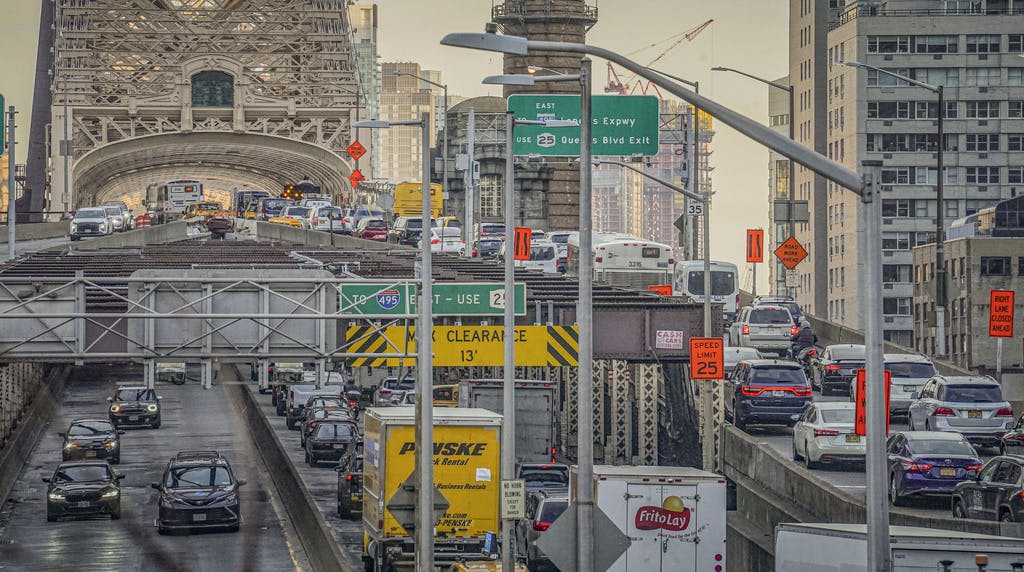Epic Cat-and-Mouse Game Between Commuters and New York Is Set To Begin Over Congestion Pricing
Billions at stake as state seeks to clamp down on drivers commuting to or visiting or otherwise driving into Manhattan.

With congestion pricing due to start dinging commuters into Manhattan’s Central Business District below 60th Street, crafty drivers are finding ways to beat the system. Foreseeing the challenges, the state seeks to increase penalties for evasion to ensure every dime is harvested.
The cat-and-mouse game will begin in mid-June for drivers without exemptions. On weekdays between 5 a.m. and 9 p.m., the charge will be $15 for passenger vehicles, $24 to $36 for trucks, and $7.50 for motorcycles. The charge is $2.50 for rideshare drivers using services such as Uber and $1.25 for taxis. Weekend peak times are 9AM to 9PM. In off hours, the fee will be dropped about 75 percent.
Drivers with E-ZPass tags will have the toll charged by electronic sensors. Those without will have a picture snapped of their license plate and be mailed a bill where the car is registered. These vehicles will have the best chance to enter the Central Business District for free by concealing their identity — and they’re already succeeding.
Last month, the MTA Bridges and Tunnels president, Catherine Sheridan, made a live-streamed presentation to the MTA Board on toll evasion. She said the number of unregistered vehicles — and ones with fake or covered plates — jumped 160 percent in 2023 from the pre-pandemic average.
Ms. Sheridan said that the evasions amounted to 1.3 percent of drivers avoiding a total of $50 million in tolls. The Port Authority executive director, Richard Cotton, told NY1 in an interview last month that about 1 percent or 2 percent of license plates passing along his agency’s routes were unreadable.
An audit in January by the city comptroller, Bradford Lander, found that the number of cars that evaded speed cameras because they had no tags or temporary ones rose 5,356 percent from 2019 to mid-2023. In the first six months of last year, cameras missed 41.5 percent of speeding drivers. Including cars with obstructed plates, $54 million in tickets went unpaid.
Innovators like Brooklyn’s 510 Auto Group are already meeting the demand with “stealth plates.” The motorized devices “cover, hide, or flip your license plates” at the push of a button. Prices range from $157.49 for motorcycles to $393.98 for the “Stealth Plate Combo” with both “curtains and flippers” to fool cameras.
“Do not use the Stealth Plates while driving on public roads,” a disclaimer on 510 Auto Group’s website reads, noting they’re for “off-road use only.” The warning recalls those made by companies selling radar detectors in decades past. While governments could ban the use of the devices, it was still legal to buy, own, and sell them.
As radar detectors proliferated, governments changed laws and technology. The fight between measures and countermeasures resulted in citizens test-driving endless new tricks to save cash. One urban legend prompted drivers to wrap their hubcaps with aluminum foil in a futile attempt to deflect signals.
Governments aren’t as nimble or creative as individuals and legislation to punish toll evasion in New York already lags. Toll evasion isn’t considered a theft-of-service crime. A driver’s registration can be suspended, but only after three toll violations in a five-year period. With the high cost of congestion pricing, it’s a risk many drivers are willing to take.
In her latest budget, the Democratic governor of New York, Kathleen Hochul, sought to ban “vanish plates” and allow police to confiscate “covers designed to make plates unreadable.” She also pushed to make toll evaders subject to arrest for a misdemeanor. But legislators have shot down such proposals in each of the past three years.
Ms. Hochul also wants to make it illegal to “register, reregister, renew, replace or transfer” registration for cars. Under existing law, drivers can load up charges on one license plate and then swap it out for a new one. The governor would switch liability to the vehicle identification number to block this method of dodging unpaid bills.
New York state requires congestion pricing to raise $1 billion a year and the MTA projects it will take up to $3.4 billion from commuters. Expect drivers, though, to find routes around the law and challenge the government at every turn, until the city and state can build better mousetraps to stop them.

